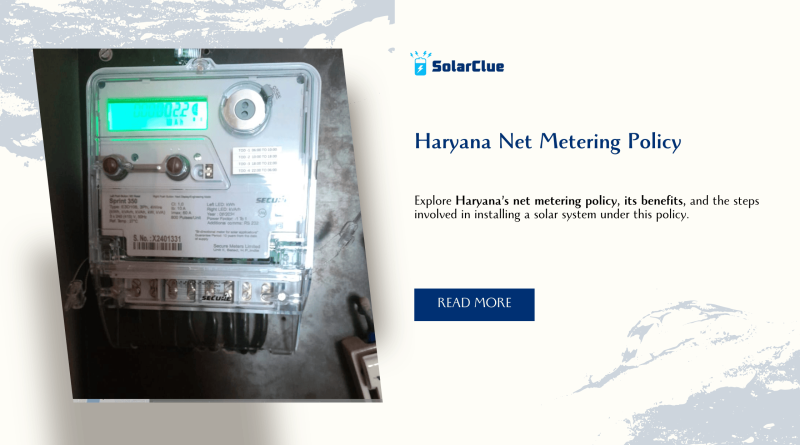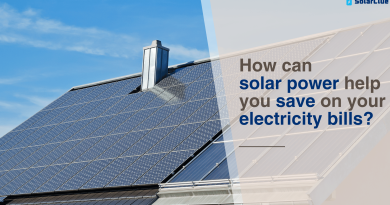Haryana Net Metering Policy
Haryana has been actively promoting renewable energy to meet its growing energy demand while also addressing environmental concerns. One of the most impactful policies in place is the Net Metering Policy, which encourages residential, commercial, and industrial consumers to adopt solar energy through rooftop solar installations. This policy allows consumers to generate their own electricity and export any excess to the grid, helping them reduce electricity costs and contribute to the state’s renewable energy goals.
In this blog, we will explore Haryana’s net metering policy, its benefits, and the steps involved in installing a solar system under this policy.
Table of Contents
What is Net Metering?
Net metering is a billing mechanism that allows consumers who generate their own electricity through renewable sources, particularly solar power, to connect their system to the grid. If the consumer generates more electricity than they need, the excess is exported to the grid. The consumer receives credits for the exported electricity, which are used to offset future electricity bills.
In Haryana, the net metering policy is governed by the Haryana Electricity Regulatory Commission (HERC), and it applies to all grid-connected consumers who install solar photovoltaic (PV) systems on their rooftops.
Key Features of Haryana Net Metering Policy
1. Eligibility Criteria
- Consumer Categories: Residential, commercial, industrial, institutional, and government consumers are eligible for net metering.
- System Size: Solar rooftop systems ranging from 1 kW to 2 MW are allowed.
- Connection Type: Consumers must be connected to the grid through Haryana’s distribution companies, such as Uttar Haryana Bijli Vitran Nigam (UHBVN) and Dakshin Haryana Bijli Vitran Nigam (DHBVN).
2. Solar System Capacity
- The solar rooftop capacity must not exceed the sanctioned load or contract demand of the consumer’s existing grid connection.
- For large-scale installations, the capacity is limited to 1 MW for residential consumers and up to 2 MW for commercial and industrial consumers.
3. Energy Settlement and Billing
- A bi-directional meter is installed to track the electricity consumed from the grid and the electricity exported back to the grid.
- Consumers are billed for the net energy consumed, which is the difference between the imported and exported energy.
- Settlement Period: Energy credits are settled on a monthly basis, and any excess credits can be carried forward to the next billing cycle. Credits not utilized within the financial year will lapse.
4. Installation and Maintenance
- Consumers are responsible for the cost of installing the solar system, including the purchase of solar panels, inverters, and bi-directional meters.
- Maintenance of the solar system, including cleaning and regular inspections, is the consumer’s responsibility.
- Installation must be carried out by approved vendors to ensure compliance with Haryana’s technical standards.
5. Government Incentives and Subsidies
- The Ministry of New and Renewable Energy (MNRE) provides subsidies for solar rooftop installations, up to 40% for systems up to 3 kW and 20% for systems between 3 kW and 10 kW.
- Haryana also offers state-level incentives to encourage more consumers to adopt solar energy and reduce the state’s dependency on fossil fuels.
Benefits of Net Metering in Haryana
1. Reduced Electricity Bills
With net metering, consumers can significantly lower their electricity bills by generating their own solar power. Any excess electricity exported to the grid earns credits, which are used to offset future bills. Over time, this leads to substantial savings.
2. Environmental Impact
Haryana’s net metering policy promotes the use of renewable energy and reduces the state’s reliance on conventional energy sources, which are often harmful to the environment. Solar power generation helps reduce carbon emissions and contributes to a cleaner, greener future.
3. Energy Independence
By generating electricity through solar panels, consumers can reduce their dependence on the grid. This leads to greater energy security, especially in areas prone to power outages or rising electricity tariffs.
4. Government Subsidies
Under the MNRE scheme, consumers can take advantage of subsidies on the installation costs of solar systems, reducing the initial investment required. Haryana’s net metering policy also provides financial support, making it easier for individuals and businesses to switch to solar energy.
5. Long-Term Savings and Returns
Although there is an initial cost associated with installing a solar system, the payback period is typically between 5 to 8 years. After this period, the system continues to generate electricity, offering long-term savings on energy bills for the remainder of the system’s lifespan, which can last up to 25 years.
Key Highlights of Haryana Net Metering Policy
| Aspect | Details |
|---|---|
| Eligible Consumers | Residential, Commercial, Industrial, Institutional, and Government |
| System Size | 1 kW to 2 MW |
| Maximum Solar Capacity | Should not exceed sanctioned load (up to 1 MW for residential, 2 MW for commercial/industrial) |
| Billing Mechanism | Net metering with a bi-directional meter |
| Excess Energy Settlement | Monthly credit for surplus energy, carried forward to next billing cycle |
| Meter Type | Bi-directional meter to track both import and export of energy |
| Subsidies | MNRE: 40% for systems up to 3 kW; 20% for systems between 3 kW and 10 kW |
| Connection | Must be connected to the grid via UHBVN or DHBVN |
| Settlement Period | Monthly, with carryover of energy credits to the next billing cycle |
| Energy Credit Validity | Unutilized credits lapse at the end of the financial year |
| Maintenance | Consumer responsible for system maintenance |
| Government Incentives | MNRE and state-level subsidies available |
| Environmental Benefits | Reduces carbon emissions and promotes the use of clean energy |
How to Apply for Net Metering in Haryana
1. Check Eligibility
Ensure that your property meets the eligibility requirements for net metering in Haryana. Your solar system’s capacity should not exceed your sanctioned load or contract demand.
2. Select an Approved Vendor
Choose an approved vendor to install your solar system. The vendor must comply with the technical standards and safety regulations set by Haryana’s distribution companies.
3. Submit Application for Net Metering
Submit an application for net metering to your electricity distribution company (either UHBVN or DHBVN). Application forms are available on the respective utility’s website or local office.
4. Install a Bi-Directional Meter
A bi-directional meter is required to measure both the electricity consumed from the grid and the electricity exported to the grid. This meter must be installed and certified by the utility company.
5. System Inspection and Approval
After installation, your solar system will be inspected by the utility company to ensure it complies with all technical standards. Once approved, the system will be connected to the grid, and you can start generating solar power under the net metering policy.
6. Start Generating Energy
Once your system is connected to the grid, it will begin generating solar energy. Any surplus energy exported to the grid will earn credits, which will reduce your future electricity bills.
Estimated Cost of Installing a Solar System in Haryana
The cost of setting up a solar power system under the net metering policy in Haryana varies depending on the system size and equipment quality. Below is a general cost breakdown for solar installations in the state.
Estimated Cost for Solar System Installation in Haryana
| Component | 1 kW System | 3 kW System | 5 kW System |
|---|---|---|---|
| Solar Panels | ₹25,000 – ₹40,000 | ₹75,000 – ₹1,20,000 | ₹1,25,000 – ₹2,00,000 |
| Inverter | ₹6,000 – ₹12,000 | ₹18,000 – ₹36,000 | ₹30,000 – ₹60,000 |
| Bi-Directional Meter | ₹5,000 – ₹10,000 | ₹5,000 – ₹10,000 | ₹5,000 – ₹10,000 |
| Mounting Structure | ₹1,500 – ₹3,000 | ₹4,500 – ₹9,000 | ₹7,500 – ₹15,000 |
| Wiring and Cabling | ₹2,000 – ₹4,000 | ₹6,000 – ₹12,000 | ₹10,000 – ₹20,000 |
| Installation and Labor | ₹5,000 – ₹8,000 | ₹10,000 – ₹15,000 | ₹15,000 – ₹25,000 |
| Total Estimated Cost | ₹44,500 – ₹77,000 | ₹1,18,500 – ₹2,02,000 | ₹1,92,500 – ₹3,30,000 |
Conclusion
Haryana’s net metering policy is a forward-thinking initiative that promotes the use of solar energy for sustainable development. By allowing consumers to generate their own electricity.
Ready to Save on Electricity Bills with Solar Power?
With Net Metering, you can drastically reduce your electricity costs by generating your own solar power and sending any excess back to the grid. It’s time to harness the sun’s energy and make a positive impact on both your wallet and the environment!
At SolarClue, we make the transition to solar simple, efficient, and affordable. Whether you’re a homeowner, business, or institution, our team of solar experts will guide you through the process—from installation to maintenance—so you can start saving from day one.
🌞 Take the first step towards energy independence today!
🔋 Get your solar consultation now!
Contact SolarClue or call us at +91-888-4444-830 to explore the best solar solutions for your home or business.
Go Solar. Save More. Power Your Future with SolarClue!



